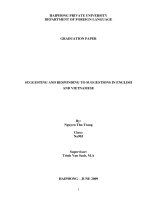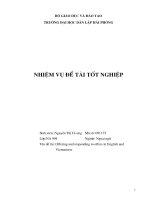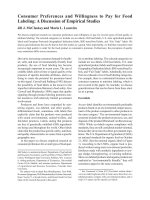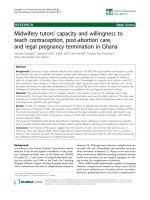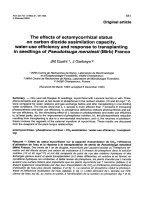Signals and Willingness to Purchase in Services
Bạn đang xem bản rút gọn của tài liệu. Xem và tải ngay bản đầy đủ của tài liệu tại đây (257.99 KB, 9 trang )
Signals and Willingness to Purchase in Services
Nguyen Dinh Tho
University of Economics HCMC, Vietnam
Abstract
The purpose of this study is to employ a signaling framework to investigate the role of marketing signals
in customers’ willingness to purchase (WIP) a service brand. Based on a sample of 297 online shopping
customers in Ho Chi Minh City, the findings produced by structural equation modeling show that brand
investment together with signal credibility positively affects WTP. Signal clarity and consistency have a
positive impact on signal credibility; signal consistency underlies signal clarity. Finally, brand investment
plays it role in all three signal characteristics – clarity, consistency and credibility. The findings confirm the
net effects of brand investment and signal characteristics on WTP. The results from necessary condition
analysis demonstrate that brand investment and signal credibility have varying levels of necessity for the
occurrence of WTP. Signal clarity, consistency and brand investment also exhibit different levels of necessity
for the occurrence of signal credibility. The study findings offer a number of implications for theory, research
and practice.
Keywords Necessary condition analysis; Signaling theory; Services; Vietnam.
1. Introduction
Information asymmetry exists in a market when “different people know different things” (Stiglitz, 2002, p.
469). A market is characterized by the asymmetry of information where providers know more about the
quality of their offers than do their customers (Connelly, Certo, Ireland, & Reutzel, 2011; Kirmani & Rao, 2000).
In such a market, signaling theory is useful and providers are able to use signals to inform their customers
about the quality of offers (Mavlanova Benbunan-Fich, & Koufaris, 2012; Nguyen, Barrett, & Nguyen, 2014).
Signaling theory, derived from information economics under the condition of asymmetric information (e.g.,
Spence, 2002; Stiglitz, 2002; Tirole, 1988), has been widely applied in business research over the past several
years (Connelly, Certo, Ireland, & Reutzel, 2011; Kirmani & Rao, 2000). In marketing, signaling theory has
been employed by researchers to study various marketing issues such as brand equity (Erdem & Swait, 1998),
warranty, product quality (e.g., Rao, Qu, & Ruekert, 1999), price and advertising (e.g., Caves & Greene, 1996),
business relationships (e.g., Alsos & Ljunggren, 2017), online retail (e.g., Rao, Lee, Connelly, & Iyengar, 2018).
The service market is an information asymmetric market because service providers know the quality of
their services better than do their consumers. As such, signaling is valuable because signals help service
providers to inform the quality of service brands to customers (Kirmani & Rao, 2000). However, little research
has been devoted to explore the usefulness of signaling theory in services, especially in transitioning markets
such as Vietnam. In addition, quantitative marketing researchers have mainly employed conventional
statistical tools such as multiple regression analysis and structural equation modeling (SEM) to test their
theories. Such conventional methods are appropriate for researchers to test the net effects (i.e., beta weights)
of independent variables on dependent variables, they are however unable to help researchers to discover the
causal complexity of social phenomena (Ragin, 2008). Fuzzy-set qualitative comparative analysis (fsQCA)
assists researchers in examining sufficient and in-kind necessary conditions for an outcome but it does not
291
support researchers in exploring the level of necessary conditions. Necessary condition analysis (NCA; Dul,
2016a) helps researchers to investigate the degree of necessary conditions for the occurrence of an outcome.
To bridge the aforementioned gaps, this study aims to apply signaling theory to investigate the role of
brand investment and signal characteristics, including signal clarity, consistency and credibility, in customers’
willingness to purchase (WTP) a service brand. Specifically, the study first uses SEM to investigate the net
effect of brand investment and signal credibility on WTP and of brand investment, signal clarity and
consistency on signal credibility. The study then employs NCA to discover the degrees of necessity of brand
investment and signal credibility for the occurrence of WTP and the degree of necessity of brand investment,
signal clarity and signal consistency for the occurrence of signal credibility. The remainder of the paper is
organized around the following key points: theoretical background and hypotheses, method, data analysis
and results, discussion and implications, and conclusions, limitations and directions for future research.
2. Theoretical background and hypotheses
Signals and signaling theory
Information asymmetry exists in a market when buyers and sellers are uncertain about the information
concerning their exchange, or when one party owns more information than the other (Alsos & Ljunggren,
2017; Connelly et al., 2011; Kirmani & Rao, 2000; Wells, Valacich, & Hess, 2011). When faced with an
information asymmetry problem, sellers and buyers will encounter a number of difficulties in making
decisions. For example, sellers of high quality products will be confronted with the positioning of their
products (goods or services) against the products offered by low-quality sellers, and buyers may have trouble
distinguishing a high-quality product from a low-quality one (Mishra, Heide, & Cort, 1998; Izquierdo &
Izquierdo, 2007). Under such a market condition, several signals can serve as a signal of product quality,
resulting in the application of signaling theory in several disciplines (Connelly et al., 2011; Kirmani & Rao,
2000). Rao et al. (1999, p. 259) define a signal as “an action that the seller can take to convey information
credibly about unobservable product quality to the buyer.” It is a piece of information on the product that is
able to assist sellers in showing the ability of their product to meet the requirements of their buyers and to
differentiate the product from other offerings, and that helps customers to make inferences about the quality
and value of the product (Heil & Robertson, 1991; Nguyen et al., 2014). The information to be conveyed can
take a variety of forms such as the product’s attributes, prices, advertising, and warranties (e.g., Li, Fang,
Wang, Lim, & Liang, 2015; Ozsomer & Altaras, 2008; Wells et al., 2011).
The quality of a product can be classified into three categories: search, experience and credence qualities
(Darby & Karni, 1973). Search-quality products “are those that can be ascertained in the search process prior
to purchase and experience-quality products are those that can be discovered only after purchase as the
product is used. Credence-quality products are those which, although worthwhile, cannot be evaluated in
normal use. Instead, the assessment of their value requires additional costly information” (Darby & Karni,
1973, pp. 68-69). The literature on signaling theory suggests that signaling theory is highly applicable to
experience-quality products because those products are characterized by a combination of high pre-purchase
information scarcity and high post-purchase information clarity (Kirmani & Rao, 2000). In such a market
condition, through a signaling process, sellers are able to reduce such an information gap, confirming their
buyers that they are selecting a high-quality product (Wells et al., 2011).
A signaling process involves three key elements: the signaler, the receiver and the signal itself. Signalers
are holders of or insiders concerning information about the unobservable (of a good or service) which is not
available to outsiders (the receiver). Such information can be positive or negative; however, signalers primarily
focus on the positive information with an attempt to convey positive attributes of the product or service
(Connelly et al., 2011). Signaling is a learning process (Heil & Robertson, 1991) in which outsiders (the receiver)
292
receive the signal, read and interpret it in the light of their experience, and react accordingly (Heil & Robertson,
1991). The detection and interpretation of a signal by the receiver depend on several characteristics of the
signal; that is, signals have different levels of effectiveness (Li et al., 2015). Some signals may be easier to be
detected and interpreted while others may not be. A number of signal characteristics have been proposed in
the literature such as signal clarity, intensity, observability, strength, visibility, consistency, credibility, and
reliability. Note that some of the above characteristics are closely related with others. For example, clarity is
similar to intensity, observability, strength and visibility; reliability has the same content with credibility
(Connelly et al., 2011; Well et al., 2011). Accordingly, three key characteristics of a signal that help the receiver
to detect and interpret the signal are clarity, consistency and credibility (Erdem & Swait, 1998; Tho, 2017).
Signal clarity refers to the absence of ambiguity in the information conveyed by the signaler. Signal consistency
is reflected in the agreement among signals sent by the signaler. Finally, signal credibility denotes the honesty
of the signaler as well as the correspondence between the signal and the signaler’s quality, making the receiver
to be confident in the signaler’s product claims (Connelly et al., 2011; Erdem & Swait, 1998; Tho, 2017).
Signaling and WTP: Conceptual model
The service market is characterized by asymmetric information, which may create higher risks for
customers because prior to actual purchase of a service brand, customers lack knowledge about the quality of
the service; that is, pre-purchase information is scarce. The quality of the service can only be evaluated when
customers complete their consumption, meaning that the quality of the service is based on customers’
experience; that is, high post-purchase information clarity. In such an experience-quality service (i.e., a
combination of high pre-purchase information scarcity and high post-purchase information clarity), signaling
theory is appropriate, and service providers can use signals to inform their customers about the quality of
their service brand (Kirmani & Rao, 2000; Wells et al., 2011). Signals can serve as a source of knowledge about
service brands, reducing the information gap in the market (Nguyen et al., 2014; Rao et al., 2018; Wells et al.,
2011). Several marketing-mix elements, such as warranties, advertising, prices, brand names, can serve as
signals. These marketing signals convey information about the service brand to customers (e.g., Erdem &
Swait, 1998). In such a setting, customers would also like information that can help them to distinguish high
quality service brands from low quality ones. Therefore, marketing signals play an important role when
consumers are not ready to evaluate the quality of a service brand before consumption.
Figure 1 depicts a conceptual model explaining the role of signal characteristics and brand investment in
WTP. The model proposes that signal credibility and brand investment have a positive effect on WTP. Signal
clarity and consistency influence signal credibility and signal consistency affects signal credibility. Finally,
brand investment underlies all three signal characteristics (clarity, consistency and credibility).
Figure 1. Conceptual model
Signal
consistency
Signal
credibility
H2
H3
H4
H6
H1
Signal
clarity
H7
WTP
H5
H8
Brand
investment
293
Signal credibility is the key characteristic of a signal because it determines the effectiveness of information
conveyed (Tirole, 1988). When a market is characterized by imperfect and asymmetric information, it is
important that a service provider should communicate credible information on its service brand to customers.
A credible signal can serve as a source of knowledge about the service brand, lessening customers’ perceived
risk as well as costs of gathering and processing information (Erdem & Swait, 1998). Accordingly, if customers
believe that the service brand’s signal is credible, i.e., the service provider is able and willing to deliver what
is promised, they form a positive attitude toward the brand, leading to the willingness to purchase the brand.
In other words, when pre-purchase information is scarce, brand credibility is an essential factor that
determines the choice of customers (Erdem & Swait, 1998; Kirmani & Rao, 2000; Tho, 2017).
H1. Signal credibility has a positive effect on WTP.
Signal clarity assists customers in easily identifying what a service provider would like to inform its target
customers, such as the brand’s attributes and position. To make a signal clear, every marketing-mix signal
should be consistent, i.e., reflecting the same attributes, objectives, position, and stable over time (Erdem &
Swait, 1998). Therefore, signal consistency is essential to signal clarity. In addition, signaling theory suggests
that most rational firms are unlikely to send false signals if the signals increase costs in terms of immediate
profits, future profits, and reputation (brand image) (Tirole, 1988). As a result, signal clarity and consistency
are vital to signal credibility because customers may believe that only quality service providers would send
clear and credible signals to their consumers.
H2. Signal consistency has a positive effect on signal credibility.
H3. Signal consistency has a positive effect on signal clarity.
H4. Signal clarity has a positive effect on signal credibility.
A service provider should invest in its service brand to demonstrate that the firm commits to the brand,
and to assure that its service claims are to be delivered (Erdem & Swait, 1998). Brand investment motivates
customers to believe that the firm is willing and able to provide them the expected service leading to a higher
level of WTP. Further, high investment in the brand enables the service provider to send clear and consistent
signals to its customers with an expectation of a return in higher credibility perceived by customers.
Consequently, investment in a brand enhances the clarity, consistency, and credibility of the brand signal.
H5. Brand investment has a positive effect on signal clarity.
H6. Brand investment has a positive effect on signal consistency.
H7. Brand investment has a positive effect on signal credibility.
H8. Brand investment has a positive effect on WTP.
3. Method
3.1. Sample and measure
A sample of 297 consumers in Ho Chi Minh City, the major business center in Vietnam, was surveyed to
test the measurement and theoretical models. Two key online-shopping service providers in Vietnam – Lazada
and Home Shopping Vietnam – were selected for the study and face-to-face interviews, the most effective
means of collecting survey data in Vietnam, was employed. Note that this study aimed to investigate noncurrent customers of these two service providers, therefore, a screening question was used to select
respondents who were not their current customers. The sample comprised 102 (34.3%) female customers and
195 (65.7%) male customers. In terms of brand, 50 (50.5%) customers were interviewed with the Lazada
questionnaire and 147 (49.5%) were interviewed with the Home Shopping Vietnam questionnaire.
Constructs examined were brand investment, signal clarity, consistency, credibility and WTP. The
measures of these constructs were borrowed from the scales developed by Erdem and Swait (1998). Brand
investments, signal clarity, and WTP were measured by three items each. Signal consistency and brand
294
credibility were measured by four items each. All items were measured by a 7-point Likert scale, anchored by
1: strongly disagree and 7: strongly agree. Note that the questionnaire was initially prepared in English and
then translated into Vietnamese by an academic who is fluent in both languages. To confirm the equivalence
of meanings between the two versions of the questionnaire (English and Vietnamese), a back translation was
also conducted by another bilingual academic. This procedure was undertaken because English is not well
understood by most Vietnamese consumers. Note also that the order of the questionnaire items was randomly
distributed to reduce the agreement tendency bias (Chang, van Witteloostuijn, & Eden, 2010).
4. Data analysis and results
4.1. Measurement validation
To value the measures of the constructs under study, confirmatory factor analysis (CFA) with maximum
likelihood estimation was employed. The maximum likelihood estimation method was used because all the
univariate kurtoses and skewnesses were within the range of [-1, 1] (Muthen & Kaplan, 1985). The CFA results
of the final measurement model indicate that the model received an acceptable fit to the data: 2(261.31)/df(106) =
2.47, GFI = 0.911, CFI = 0.942, and RMSEA = 0.070. All item loadings on the factors were significant and
sufficient ( ≥ 0.55). Composite reliability (CR) and average variance extracted (AVE) of all constructs were
acceptable (CR ≥ 0.67, AVE ≥ 0.58). These findings support the requirements for unidimensionality and withinmethod convergent validity (Steenkamp & van Trijp, 1991). In addition, the correlation of any pair of
constructs was less than the root square of average variance extracted of each construct in the pair, supporting
between-construct discriminant validity (Fornell & Larcker, 1981).
4.2. Common method bias
To control the possibility of common method bias due to the use of cross-sectional data collected from a
single respondent (customers), this study used a number of procedures as follows. As noted previously, in the
design phase, the order of the questionnaire items was randomly distributed. In the analysis phase, two
statistical tests were conducted. A CFA Harman’s single factor model test (Podsakoff, MacKenzie, Lee, &
Podsakoff, 2003) was first conducted, and then, an unmeasured latent variable test (allowing the unmeasured
latent variable to load on each item in the trait model; Markel & Frone, 1998) followed.
The CFA Harman test shows that the one-factor model received a very poor fit to data [2(966.09)/df(116) =
8.33, GFI = 0.715, CFI = 0.685, and RMSEA = 0.157], compared to the trait factor model [2(261.31)/df(106) = 2.47,
GFI = 0.911, CFI = 0.942, and RMSEA = 0.070]. Further, the unmeasured latent variable test reveals that all
CFA loadings of items measuring the constructs were not statistical significant and that these item-loadings
were almost identical to those reported in the saturated CFA model. The results of these two statistical tests
indicate that if the common method variance existed, it did not make results of this study biased. Note that no
improper solutions were found in any results of the CFA tests (Heywood cases, i.e., negative variances, were
absent; all standardized residuals were less than |2.58|).
4.3. Testing the net effect with SEM
SEM was employed to investigate the net effects of the three signal characteristics (clarity, consistency and
credibility) and brand investment on WIP. The results produced by SEM show that the theoretical model
received an acceptable fit to the data [2(262.98)/df(108) = 2.44, GFI = 0.910, CFI = 0.942, and RMSEA = 0.070] and
that no improper solutions were found in the results of the SEM test (Heywood cases, i.e., negative variances,
were absent; all standardized residuals were less than |2.58|). Table 1 demonstrates the unstandardized and
standardized estimates of the structural coefficients.
295
Table 1. Regression weights
Hypothesis
H1
Path
Signal credibility → WTP
B
0.48
SE
0.138
β
0.34
t
3.45
p
0.000
H2
Signal consistency → Signal credibility
0.47
0.067
0.46
6.95
0.000
H3
Signal consistency → Signal clarity
0.36
0.071
0.37
5.04
0.000
H4
Signal clarity → Signal credibility
0.24
0.070
0.23
3.43
0.000
H5
Brand investment → Signal clarity
0.41
0.105
0.38
3.88
0.000
H6
Brand investment → Signal consistency
0.54
0.108
0.50
5.04
0.000
H7
Brand investment → Signal credibility
0.34
0.103
0.30
3.25
0.001
H8
Brand investment → WIP
0.37
0.177
0.23
2.07
0.038
Note: B: unstandardized estimate; SE: standard error; β: standardized estimate; t: t-value; p: p-value.
The SEM results (Table 1) indicate that signal credibility positively influences WTP (p < 0.001), supporting
hypothesis H1. Signal consistency enhances both signal credibility and signal clarity (p < 0.001), which in turn
underlies signal credibility (p < 0.001), thus supporting hypotheses H2, H3 and H4. Finally, brand investment
has a positive effect on all three signal characteristics (clarity, consistency and credibility; p < 0.01) and on
WTP (p < 0.05), thus supporting hypotheses H5, H6, H7 and H6.
4.4. Discovering in-degree necessary conditions with NCA
NCA were employed to discover the level of necessity of (1) brand investment and signal credibility for
the occurrence of WTP, and of (2) brand investment, signal clarity and consistency for the occurrence of signal
credibility. NCA is an analysis method that supports researchers in identifying the degree of a necessary (but
not sufficient) condition for an outcome. To examine the level of a necessary condition, NCA determines the
ceiling line, the line that separates the area with observations from the area without observations. Two
common techniques used for determining ceiling lines are the ceiling envelopment technique (a piecewise
linear line) with free disposal hull (CE-FDH) and the ceiling regression (a straight line) with free disposal hull
(CR-FDH) because they are more flexible techniques (Dul, 2016a). Note that composite measures of the
constructs examined were used in NCA because they were unidimensional (Gerbing & Anderson, 1988).
The NCA results produced by the NCA package (Dul, 2016b) included the bottleneck table (Tables 2 and
3), and the CE-FDH and CR-FDH ceiling lines for each condition (predictor). Table 2 shows the level of
necessity of two conditions (brand investment and signal credibility) for WTP. For example, to reach 90% of
WTP, it is necessary that brand investment should be at least 23.5% if using the CE-FDH ceiling line, and at
least 20.8% if using CR-FDH ceiling line. Table 3 demonstrates the level of necessity of three conditions (brand
investment, signal clarity and consistency) for signal credibility. For the occurrence of WTP, brand investment
receives the highest effect size: d(CE-FDH) = 0.052 and d(RE-FDH) = 0.046 (Table 2). For the occurrence of signal
credibility, signal consistency receives the highest effect size: d(CE-FDH) = 0.207 and d(RE-FDH) = 0.181 (Table 3).
Table 2. Bottleneck table: Required minimum levels of brand investment and signal credibility
for different desired levels of WTP
WTP (%)
0
10
20
30
40
a. CE-FDH (%)
Brand investment
Signal credibility
NN
NN
NN
NN
NN
NN
NN
NN
NN
NN
296
b. CR-FDH (%)
Brand investment
Signal credibility
NN
NN
NN
NN
NN
NN
NN
NN
NN
NN
50
60
70
80
90
100
Effect size (d)
NN
NN
5.9
5.9
23.5
41.2
0.052
NN
NN
NN
20.8
20.8
20.8
0.049
NN
NN
NN
9.6
22.8
36.0
0.046
NN
NN
NN
2.1
11.5
20.8
0.023
Note: CE-FDH: Ceiling Envelopment with Free Disposal Hull; CR-FDH: Ceiling Regression with Free Disposal Hull; d: effect size;
NN: Not necessary.
Table 3. Bottleneck table: Required minimum levels of brand investment, signal clarity and consistency
for different desired levels of signal credibility
Signal
credibility
(%)
0
10
20
30
40
50
60
70
80
90
100
Effect size (d)
Brand
investment
NN
NN
NN
NN
NN
NN
NN
NN
NN
NN
52.9
0.022
a. CE-FDH (%)
Signal
Signal
clarity
consistency
NN
NN
NN
NN
NN
NN
NN
NN
NN
NN
NN
NN
5.6
25.0
5.6
25.0
38.9
54.2
55.6
62.5
83.3
62.5
0.164
0.207
Brand
investment
NN
NN
NN
NN
NN
NN
NN
NN
NN
NN
52.9
0.011
b. CR-FDH (%)
Signal
Signal
clarity
consistency
NN
NN
NN
NN
NN
NN
NN
NN
NN
NN
NN
1.4
NN
15.3
18.6
29.2
37.5
43.0
56.5
56.9
75.5
70.8
0.150
0.181
Note: CE-FDH: Ceiling Envelopment with Free Disposal Hull; CR-FDH: Ceiling Regression with Free Disposal Hull; d: effect size;
NN: Not necessary.
5. Discussion and implications
Of particular interest of this study is to explore the role of marketing signals in customers’ willingness to
purchase a service brand. The results produced by SEM show that brand investment together with signal
credibility positively affects WTP. Signal clarity and consistency have a positive impact on signal credibility;
signal consistency underlies signal clarity. Finally, brand investment plays it role in all three signal
characteristics – clarity, consistency and credibility. The findings confirm the net effects of signal
characteristics and brand investment on WTP. The results from NCA demonstrate that brand investment and
signal credibility have different levels of necessity for the occurrence of WTP. Signal clarity, consistency and
brand investment also exhibit varying levels of necessity for the occurrence of signal credibility. The findings
of this study offer a number of implications for theory, research and practice.
In terms of theory and research, the current study applies a signaling framework to investigate customers’
willingness to purchase a service brand, an area which has largely been ignored in prior research. The
empirical evidence confirms that, together with cognitive psychology, signaling theory is an appropriate
framework for research on service brands in general and WTP in particular. Thus, this study provides an
alternative theoretical framework for investigating WTP under the condition of asymmetric information. The
results from the two methods of data analysis (SEM and NCA) reveal that brand investment together with
signal credibility play important roles in WTP. Also, brand investment, signal clarity and consistency help
enhance the credibility of a marketing signal perceived by customers.
297
Over the past several years, several studies have investigated the impact of signal characteristics on WTP
and other outcomes (e.g., Erdem & Swait, 1998; Nguyen et al., 2014; Tho, 2017). However, such studies focus
solely on the net effects. This study is among the first to examine the level of necessity of these conditions
(predictors) for an outcome. The study, therefore, may support researchers in better understanding the
complexity of relationships between study variables, especially, the degree of necessary conditions for an
outcome. Accordingly, the study sheds light on a new way of research on signaling in services, especially in
transitioning markets such as Vietnam. SEM assists researchers in discovering the net effect of these predictors
of both WTP and signal credibility, and NCA discovers their degrees of necessity. Thus, NCA and SEM
findings are complementary to each other and this signals researchers to think of the use of both methods of
data analysis in their studies.
In practice, the results give an important implication to service marketers. When a market is characterized
by information asymmetry, a service firm should send clear, consistent and credible signals to stimulate
customers’ WTP. Further, the service firm should invest in its service brand in order to fulfill what is promised.
This will benefit the firm in terms of profits and reputation (brand image) if it sends truthful signals. However,
it is crucial to understand that a credible signal has a bonding component and the firm will incur a cost (loss
of brand image) if the signal is false. More importantly, the firm should pay attention not only to the net effect
but also to the level of necessity of the conditions that underlie signal credibility and WTP. The study findings
indicate that these conditions have varying levels of necessity. Firms, especially those in transitioning markets
like Vietnamese firms whose resources are limited compared to firms in advanced economies, should specify
the target level of outcomes (credibility and WTP) and then identify the level of necessity of their conditions
for each target outcome.
6. Conclusions, limitations and future research directions
In conclusion, the service market is characterized by a combination of high pre-purchase information
scarcity and high post-purchase information clarity, and signaling theory is an appropriate framework for the
study of such a market. Service marketers can employ marketing signals to inform their customers about the
quality of their service brands (Connelly et al., 2011; Kirmani and Rao, 2000; Wells et al., 2011). This is because
customers have difficulties in evaluating the quality of service before their actual purchase. Accordingly,
service marketers should send clear, consistent and credible signals to convince their customers about the
quality of their service brands.
This study has a number of limitations. First, the study focuses only on on-line shopping services. Signaling
frameworks can be applied in a variety of services. Future research should employ signaling theory to
investigate different types of services in order to establish key similarities and differences between services.
Further, this study investigates the role of brand investment and signal characteristics in WTP. Future research
should examine the role of signal characteristics together with other marketing factors such as the marketingmixed elements. In so doing, researchers will be able to compare and contrast the relative importance of these
factors in explaining WTP, especially, their degrees of necessity for WTP.
References
Alsos, G. A., & Ljunggren, E. (2017). The role of gender in entrepreneur–investor relationships: A signaling theory approach.
Entrepreneurship Theory and Practice, 41(4), 567-590.
Caves, R. E., & Greene, D. P. (1996). Brand’s quality levels, prices, and advertising outlays: Empirical evidence on signals and information
costs. International Journal of Industrial Organization, 14(1), 29-52.
Chang, S.-J., van Witteloostuijn, A., & Eden, L. (2010). From the editors: Common method variance in international business research.
Journal of International Business Studies, 41(2), 178-184.
Connelly, B. L., Certo, S. T., Ireland, R. D., & Reutzel, C. R. (2011). Signaling theory: A review and assessment. Journal of Management, 37(1),
39-67.
Darby, M. R., & Karni, E. (1973). Free competition and the optimal amount of fraud. Journal of Law and Economics, 16(1), 67-87.
Dul, J. (2016a). Necessary condition analysis (NCA): Logic and methodology of 'necessary but not sufficient' causality. Organizational
Research Methods,19(1), 10-52.
298
Dul, J. (2016b). R package NCA (Version 2.0), Retrieved from NCA/index.html
Erdem, T., & Swait, J. (1998). Brand equity as signaling phenomenon. Journal of Consumer Psychology, 7(2), 131-157.
Fornell, C., & Larcker, D. F. (1981). Evaluating structural equation models with unobservable variables and measurement error. Journal of
Marketing Research, 18(1), 39-50.
Gerbing, W. D., & Anderson, J. C. (1988). An update paradigm for scale development incorporating unidimensionality and its
assessments. Journal of Marketing Research, 25(2), 186-192.
Heil, O., & Robertson, T. (1991). Toward a theory of competitive market signaling: A research agenda. Strategic Management Journal, 12(6),
403-418.
Izquierdo, S.S., & Izquierdo, L. R. (2007). The impact of quality uncertainty without asymmetric information on market efficiency. Journal
of Business Research, 60(8), 858-867.
Kirmani, A., & Rao, A. R. (2000). No pain, no gain: A critical review of the literature on signaling unobservable product quality. Journal of
Marketing, 66(2), 66-79.
Li, H., Fang, Y., Wang, Y., Lim, K. H., & Liang, L. (2015). Are all signals equal? Investigating the differential effects of online signals on
the sales performance of e-marketplace sellers. Information Technology & People, 28(3), 699-723.
Markel, K. S., & Frone, M. R. (1998). Job characteristics, work–school conflict, and school outcomes among adolescents: Testing a structural
model. Journal of Applied Psychology, 83(2), 277-287.
Mavlanova, T., Benbunan-Fich, R., & Koufaris, M. (2012). Signaling theory and information asymmetry in online commerce. Information
and Management, 49(5), 240-247.
Mishra, D. P., Heide, J. B., & Cort, S. G. (1998). Information asymmetry and levels of agency relationships. Journal of Marketing Research,
35(3), 277-195.
Muthen, B., & Kaplan, D. (1985). A comparison of some methodologies for the factor analysis of non-normal Likert variables. British
Journal of Mathematical and Statistical Psychology, 38(2), 171-189.
Nguyen, M. T. T., Barrett, N. J., & Nguyen, T. D. (2014). Using signals to initiate importer-exporter relationships: Evidence from
Vietnamese importers. Journal of Business-to-Business Marketing, 21(2), 111-122.
Ozsomer, A., & Altaras, S. (2008). Global brand purchase likelihood: a critical synthesis and an integrated conceptual framework. Journal
of International Marketing, 16(4), 1-28.
Podsakoff, P. M., MacKenzie, S. B., Lee, J. -Y., & Podsakoff, N. P. (2003). Common method biases in behavioral research: A critical review
of the literature and recommended remedies. Journal of Applied Psychology, 88(5), 879-903.
Ragin, C. (2008). Redesigning social inquiry. University of Chicago Press, Chicago, IL.
Rao, S., Lee, K. B., Connelly, B., & Iyengar, D. (2018). Return time leniency in online retail: A signaling theory perspective on buying
outcomes. Decision Sciences, 49(2), 275-305.
Rao, A. R., Qu, L., & Ruekert, R. W. (1999). Signaling unobservable product quality through a brand ally. Journal of Marketing Research,
36(2), 258-268.
Spence, M. (2002). Signaling in retrospect and the informational structure of markets. American Economic Review, 92(3), 434-459.
Steenkamp, J. E. M., & van Trijp, H. C. M. (1991). The use of LISREL in validating marketing constructs. International Journal of Research in
Marketing, 8(4), 283-299.
Stiglitz, J. E. (2002). Information and the change in the paradigm in economics. American Economic Review, 92(3), 460-501.
Tho, N. D. (2017). Using signals to evaluate the teaching quality of MBA faculty members: FsQCA and SEM findings. Education and
Training, 59(3), 292-304.
Tirole, J. (1988). The theory of industrial organization. MIT Press, Cambridge, CA.
Wells, J. D., Valacich, J. S., & Hess, T. J. (2011). What signal are you sending? How website quality influences perceptions of product
quality and purchase intentions. MIS Quarterly, 35(2), 373-396.
299



